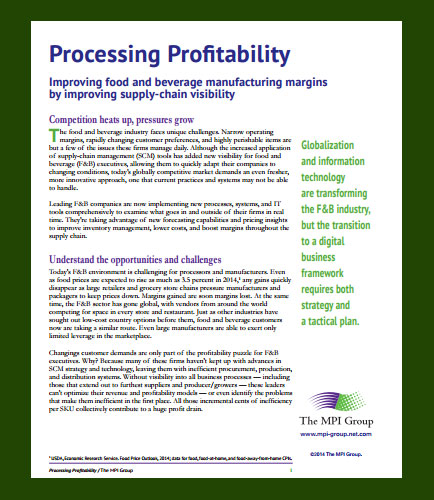
PROCESSING. PLEASE WAIT...


White Paper: The MPI Group
How to Improve food and beverage profit margins:
Much like a well-prepared dish, when it comes to software, the right ingredients make all the difference.
The food and beverage industry deals with narrow operating margins, rapidly changing customer preferences, and highly perishable items on a daily basis. Although current supply chain management (SCM) tools provide food and beverage executives more visibility to help them quickly help their companies adapt to changing conditions, today’s globally competitive market demands an even fresher, more innovative approach.
What are the market trends and strategies in the food & beverage manufacturing business?
How can the effective use of SCM tools help in the management of food and beverage industries?
What are the most common challenges faced by the food and beverage industries in managing food and beverage supply chain?
Read this whitepaper to learn how modern supply chain management systems, business analytics and IT tools can help transform today’s food and beverage industry business challenges into opportunities.
By: Software AG
Digital business transformation is based on an IT architecture transformation with a roadmap for digital capability implementation. Based on the software platforms, digital companies create enhanced or totally new business models which offer completely new digital customer experiences. Established companies are building up software know-how and are acquiring software companies to accelerate their digital transformation by injecting software innovation capabilities into their core business areas. This whitepaper helps to understand what makes today’s digital challengers attractive to customers and consumers, as it highlights their core competencies and differentiators based on their digital software-based technology. Key takeaways from this whitepaper: Digital challengers separate companies from their customers Implementing digital capabilities for digital use cases Digital companies have a micro services-oriented, scalable IT architecture
By: Jedox
The most flexible Business Intelligence (BI) platform, QlikView, allows its users to gain valuable insights by understanding the fine line between the relevant data and the redundant data. It stimulates unrestricted analysis of application data, thus helping users make timely and accurate decisions. If you are already aware of the above mentioned BI platform, then here’s an investment solution that would add on to the values of your Qlik investment. This white paper reveals the concealed facet of the same BI tool that could be coherently integrated with an extension facilitating freedom and flexibility for everyone in the company, in terms of analyzing planning data. This QlikView white paper unfolds how you can enhance your Qlik system with data capture and write-back to the database as well as specific planning functionality such as easy top-down planning and driver-based bottom-up planning, unifying Business Intelligence (BI) with Corporate Performance Management (CPM).


 2025 All Rights Reserved | by: www.ciowhitepapersreview.com
2025 All Rights Reserved | by: www.ciowhitepapersreview.com